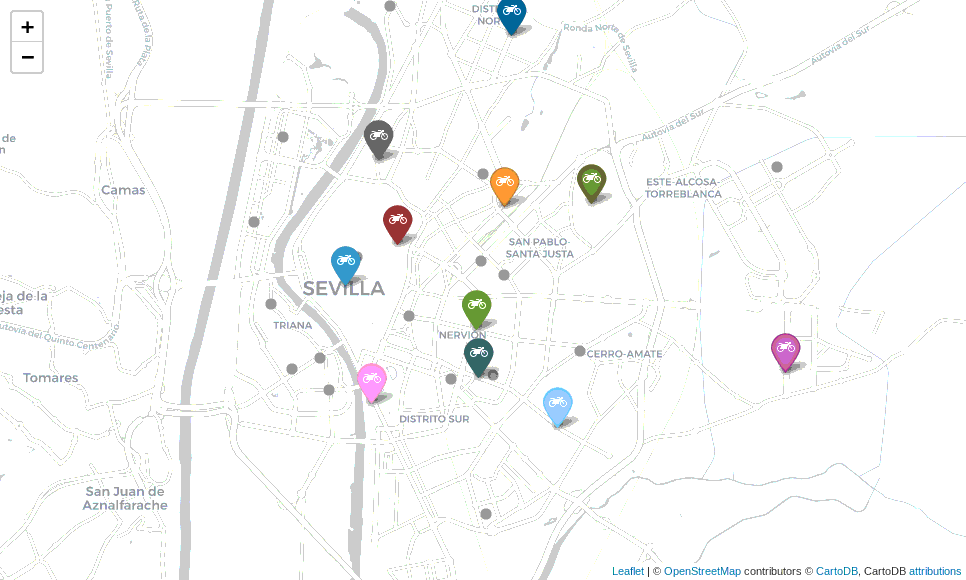Product

In this series of articles we will talk about how the equipment of Routal.com internally at the level of the team, product, customers, processes, etc. What do we hope to achieve? Transparency, trust, growth, support, ideas, recruitment, and so on. Sharing will help others, and I am convinced that it will help us to improve.
Shall we start?
In this article, we'll talk about product development. For a company like Routal, the product is a very important part of the company. The product is the tool we developed and that helps our customers to improve their processes and achieve a shared mission:”Improve the delivery experience”. For this reason, we have defined some pillars on which all development must be maintained and the entire team must work to ensure that they are respected: (the temptations that await us will be great...)
- The team decides, the customers suggest
- If it is urgent, it is created. Outside.
- Feedback, feedback, feedback
- The user makes decisions, the machines solve problems
1. The team decides, the customers suggest
This point is key to having a coherent, consistent product that maintains a long-term vision. As much as we are a startup and each client brings you closer to the dream Break Even, if you are not very clear about your long-term product vision, you will end up filling the product with “mandatory” customized features to be able to close “the contract of the year” that could possibly affect the future of your product and company.
In my opinion, it's usually a really bad idea to do this kind of thing if what you want is to be a product company. If you're a consultant, you make a living from it. Being clear about it is important. We have made this mistake in the past, and surprise, it doesn't work 😅
. There's nothing worse than being a product company that does “consulting stuff”. (You can learn from everything...) With this I don't want to despise the business of consulting firms, on the contrary, it's their business, a different business, and we rely on it, but we don't try to compete against it. On the contrary, together we can do better things for our customers. That's the goal!
What value does it give us to be clear that we are a product company? Sometimes it's better to say, no to a customer. You are going to consume less commercial resources (tons) of technical resources in something that may not provide value to other customers. Our point of view, is that you will value suggestions to enter the roadmap if you really detect a clear alignment with your long-term vision and mission (”Improve the delivery experience“). What do we achieve with this? Really assess if that “key” functionality is really essential for the customer to make decisions (AKA). Buy/Don't Buy). This information will allow us to assess the importance of that requirement. Above all, letting ideas rest allows us to evaluate the repetitiveness of that request. That's the key to identifying the importance in many other customers.
Hint: A lot of times customers want things, which they don't really need. The best way to know if they really need it, is to put a price on it, (oh surprise!) In many cases it's not usually that important... It's like buying a car, everyone wants a Maseratti, but to go to work with a more modest one you can get there, (and it even has air conditioning! 😉)
The people at 37Signals wrote a great book ReWork from which we have learned and applied several things, although it boils down to saying no to a customer can bring a lot of value.
In future articles we will talk about Lead Tech Map a methodology (which I helped create 😄) for the formation of high-performance teams and you'll see why it's so important and how it affected the company without being aware of it... (stay tuned)
2. If it is urgent, it is created. outta
Sometimes, there are certain features that are essential for customers. This type of moment is when you need to have a couple of consultants you can trust to create those features that your client needs. The thing is that you don't believe them, they are created outside. Look for a team dedicated to satisfying the smallest detail of your customer. Adapting the solution specifically to your business and processes. The benefits are many, you work on a standard product with its own customization. The customer has exactly what they need in that specific part they are asking for, which perhaps your product is not able to offer a solution. Another important benefit is the velocity. A product team always has an endless list of things to do. Getting to climb something on that list is difficult. Someone from outside will be more willing to start earlier and achieve results in less time. El opportunity cost, is not despicable in any sector...
At the product level, very intensive work has been done to facilitate this type of integrations through a Very complete and easy to integrate API. This architecture facilitates the integration of third parties and allows our team to scale horizontally and in an orderly manner tomorrow. What is being said so often, having good foundations helps you to have a good house.
3. Feedback, Feedback, Feedback
In other words, ask your customers what they think of the new features. There are several ways, the most effective one is to ask directly 😯. In some strategic clients, we even have recurring meetings that allow us to evaluate different aspects:
- Satisfac: To know firsthand if something isn't right. It is critical to be able to provide a solution and above all not to lose that customer.
- Functionality: A strategic customer is usually one who uses your product very intensively. Who better than him to make new suggestions? (Remember the First point)
- Vision of the future: Sharing your future new features allows you to evaluate them even before you start working on them. This allows us to validate if that great idea will bring value to customers or not.
Another way to evaluate if something is working or not is to monitor its use. We have tracking systems in place (Thank you Mixpanel!) of the use of certain system actions that allow us to identify what each user does. If he completes certain steps and manages to follow the ideal path that we have designed for him, we measure how many are left on the way. This helps us identify those users with the greatest potential and direct our customer success team to them to further improve their experience.
Hint: If you want to get more support, just use the tool a lot, I'm sure they'll contact you to help 😉
The feedback comes not only from strategic customers, but also from users who have just entered the tool. Talking to the more users the better allows us to improve our User Persona, improve our internal feedback (in future episodes we will talk about our roadmap meetings) and especially the perception that users have about our product. You're not alone in front of the screen! 😇
It is key that they see that there is a team of people behind them to help them improve their knowledge of the tool and to get the most out of it. It all comes back to your experience and the return from using it. ¡Or is it that someone is considering abandoning WhatsApp?! It's so embedded in our lives that we don't consider getting out of there.
Experience is everything. If our mission is to improve your delivery experience, we must make the user experience of our tool as easy, friendly and simple as possible that you will see in a few minutes how we are going to help you in The mission we share. “Improve the delivery experience” (Overcommunicated...)
4. User makes decisions, the machine solves problems
Something simple and basic to understand. The product has to solve problems, the decisions are made by the user. This means that by understanding the process in which the tool helps, we cannot generate more problems than we come to solve. For this reason, the ease of use of the tool is one of the most important pillars of Routal. The time of our users is precious, every second we can save them is time that they will be able to dedicate to other tasks and thus improve their productivity.
Another reason that led us to this principle is that in logistics processes there are no two people who make the same decision. Especially in the area of route planning. The flexibility of the tool should allow that, after our suggestion, the user can decide at all times to make changes, to be “master, owner and lord” of your process, that you get paid for something, right? Having the power to decide creates great responsibility. Having no decision-making power makes you a slave to the product. This generates tension, rejection and distrust about the tool and in the face of any case not foreseen by the tool... everything becomes hell 😤
(A little humor is always welcome with machines... Computer says no)
We hope it was useful, entertaining and if you were able to learn something from us 🐒
will make leaps of joy! Any feedback, comments that make us better will be welcome!
PS: This article wants to make our organization more transparent, to help us understand our decisions, even if sometimes we can make mistakes...

Sant Jordi is always a special day, books, roses, queues and people, lots of people. Everyone is out on the street, enjoying a magical day for both children and adults. It is the day of the year when the most books are sold, 7.5% of annual sales In the city of Barcelona.

This year will be special. We'll have to spend it at home, enjoying a good read, our recommendation for these days The Black Swan by Nassim Taleb. This year we will save ourselves the hassle of Las Ramblas and we will have to buy the roses online. Without a doubt, a special year.
We want to take advantage of this important date to see the success of initiatives that, in a normal year, would hardly have achieved such overwhelming success.
One of our customers Santjordiacasa.com is using Highway as a tool to optimize the distribution of roses on such a special date as Sant Jordi.

Thanks to the power of the Highway route planner, they have been able to grow in deliveries and reach customers that would have been impossible for them before.
Like them, hundreds of other customers are entering a world such as home delivery. A channel that had often been completely forgotten. Thanks, or unfortunately, COVID-19 has forced the launch of new marketing channels such as Ecommerce and its own distribution and home delivery.
We are seeing this in our traditional customers, distribution companies to the HORECA channel that are converting to home distributors overnight.
Pastry shops such as Cropics they were able to deliver all the Easter monkeys in record time and have the detail of leaving a monkey at my wife's grandmother's house 😁. These types of details make being able to help small businesses make you proud of the work you do and of seeing how you can help more people around you.

We are in a very difficult time for many companies and families. There is little help to get through this crisis and reaching those people we can help is always a challenge. I encourage you to share our story, the story of our users and customers, companies that are embarking on a new adventure, delivery. Without experience, without processes, but with a desire to fight and face the corona, you are not alone.
We won this together.

The distribution on demand is an industry that is growing at a very high speed. New companies appear every day, especially in the market for food, beverages and deliveries of perishable products. And the competition is wild. Efficiency is a key metric in the “I want it all and I want it now” era and the most critical part is what happens from when a new order is placed until it is delivered.
Today I want to focus on the problem of sending new orders, that is, how to decide which courier service the order should be assigned to when an order enters the system. This is because the dispatch today is not addressed systematically. Optimizing the dispatch system can minimize delivery time and improve customer satisfaction.
The operating paradigm of companies that deliver on demand can be divided into two different types:
- Operations based on a single warehouse are those operations focused on a single tank. This warehouse has several dealers and the programming is done once to obtain an order list; usually grouping orders by area. Amazon Prime is a good example of this paradigm.
- Operations based on multiple warehouses are those operations that rely on choosing the order in one of the multiple warehouses and delivering it to a customer. In this case, the delivery people are scattered around the city, and once a new order arrives, it is assigned through a shipping process to one of the multiple delivery people. Companies such as Uber, Just Eat, Delivero, etc. operate this way.
The problem of dispatching is solved more or less satisfactorily in the first scenario thanks to the possibility of linking together a list of deliveries and considering it as a Traveling Seller Problem (Traveling Salesman Problem) with some pre-clustering restrictions (OK, I know that TSP is an expensive problem, but... come on, it's about Amazon).
On the contrary, in the second scenario, it is not so clear that the problem is being optimally addressed. How can a new incoming order be added to a running scenario? There are tons of variables to consider:
- Can the courier make multiple collections before starting to deliver?
- Can an already assigned order be reassigned to another courier service?
- Do all orders have the same priority? (for example, all orders must be delivered no later than 30 minutes after placing them)
Do orders need to be delivered by a particular vehicle? - ...

Modeling this scenario can be quite challenging, and that's why SmartMonkey has been working on this problem for a while. We call our solution Online Programming Optimization Model (OSOM) (Yes, branding isn't one of our strengths 😅, but phonetically it sounds like “incredible” and that's pretty fun). OSOM can model business restrictions and find a feasible solution to the dispatching problem.
In the simulation below, we have modeled a world where:
- A courier service can be assigned multiple pickups and deliveries at the same time
- and the first next service of each messaging service is fixed and cannot be reassigned in subsequent iterations.
The visualization contains twenty iterations of the world divided into two steps:
1. New incoming services are marked in gray.
2. Services are dynamically assigned to deliverers to optimize overall delivery time.






.png)


